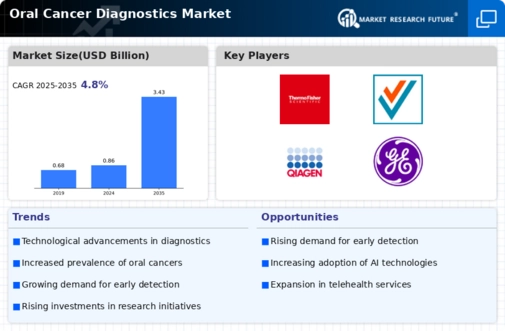Market Trends
Key Emerging Trends in the Oral Cancer Diagnostics Market
Oral cancer is a growing concern worldwide, prompting the need for more effective diagnostic methods to address this global health challenge. One such promising tool is the use of toluidine blue dye, which has shown remarkable potential in diagnosing oral cancer and identifying potential lesions with an impressively low false negative rate. Alongside this innovative approach, complementary methods like brush biopsy and fluorescence imaging contribute to the arsenal of advanced technologies that are enhancing oral cancer detection. These advancements signal substantial growth in the oral cancer diagnostics market.
The landscape of oral cancer diagnostics is undergoing a significant transformation with a surge in research activities. Recent studies have uncovered a multitude of biomarkers present in saliva, demonstrating great potential for diagnosing various oral diseases. This breakthrough discovery opens up new avenues for early screening, accurate diagnosis, prognosis evaluation, and effective therapy monitoring for both oral and systemic diseases. The evolving nature of this field presents an attractive prospect for clinicians and researchers actively involved in clinical diagnosis and screening.
The utilization of toluidine blue dye is a noteworthy advancement in the realm of oral cancer diagnostics. This dye has emerged as a valuable tool in the diagnosis of oral cancer and potential lesions. Its notable feature of a very low false negative rate enhances its reliability as a diagnostic aid. As part of the evolving diagnostic landscape, methods like brush biopsy and fluorescence imaging complement the capabilities of toluidine blue dye, contributing to a comprehensive approach in detecting and addressing oral cancer.
Brush biopsy, another contemporary method, involves the collection of cells from the oral tissue for examination. This technique aids in the identification of abnormal cells, assisting in the early diagnosis of oral cancer. Fluorescence imaging is another innovative approach that utilizes light to detect abnormalities in the oral tissues. It enhances visualization and aids in the identification of potential areas of concern, further contributing to the accuracy of oral cancer diagnosis.
The surge in research within the field of oral cancer diagnostics is a pivotal development. Recent studies have focused on exploring biomarkers present in saliva, presenting a non-invasive and accessible means of diagnosing various oral diseases. Saliva biomarkers offer a promising avenue for early detection, allowing for timely intervention and management. This research-driven approach contributes to the continual improvement of diagnostic methods, ensuring a more comprehensive understanding of oral diseases and their systemic implications.
The evolving landscape of oral cancer diagnostics not only benefits patients through early detection and improved treatment outcomes but also presents opportunities for clinicians and researchers. The integration of advanced technologies, such as toluidine blue dye, brush biopsy, and fluorescence imaging, into diagnostic practices reflects the commitment to enhancing accuracy and efficiency in oral cancer detection. As research efforts progress, the field holds the promise of even more sophisticated diagnostic tools and approaches, further solidifying its role in global healthcare. Clinicians and researchers engaged in clinical diagnosis and screening are poised to play a vital role in shaping the future of oral cancer diagnostics, ensuring better outcomes for individuals facing this health challenge.







Leave a Comment